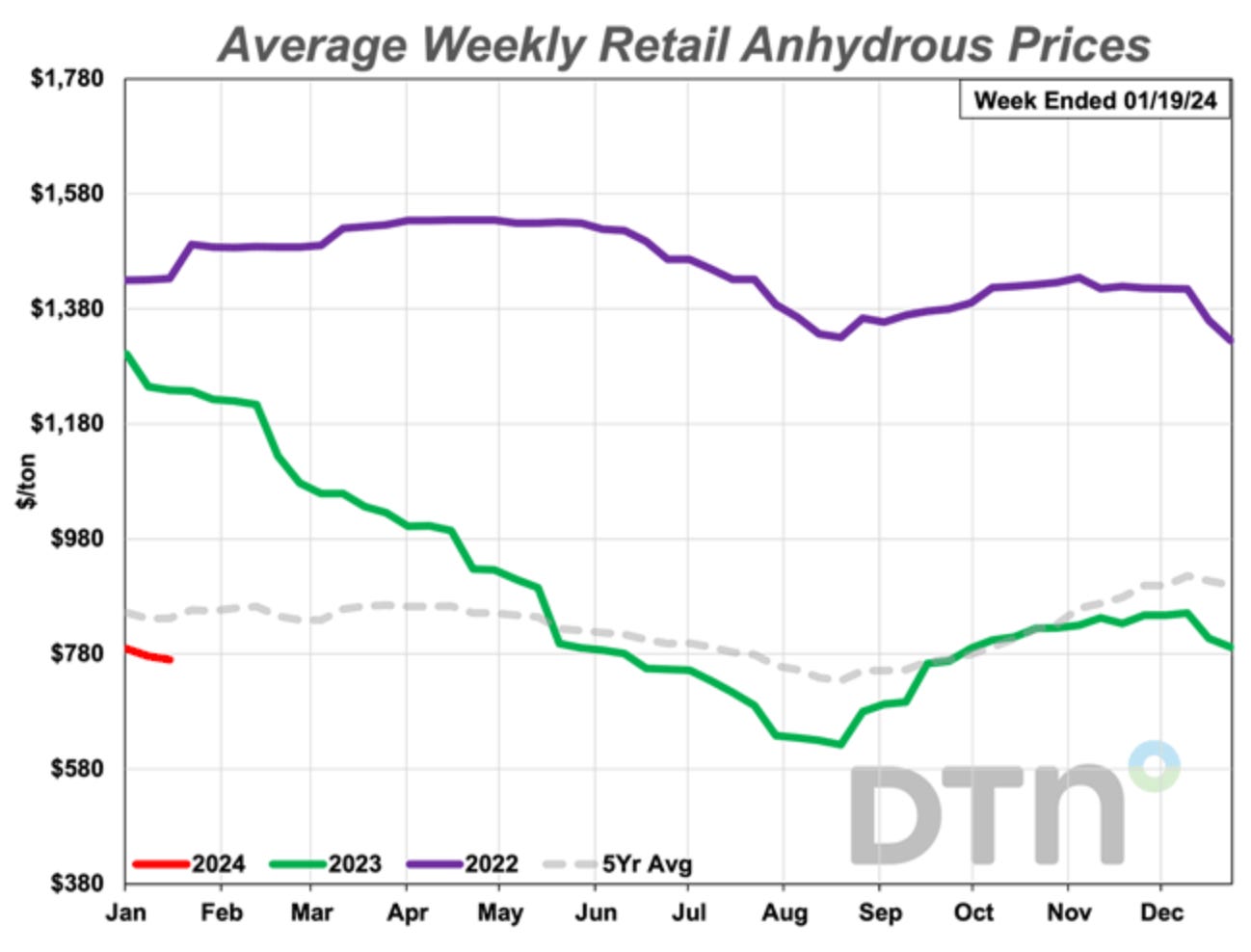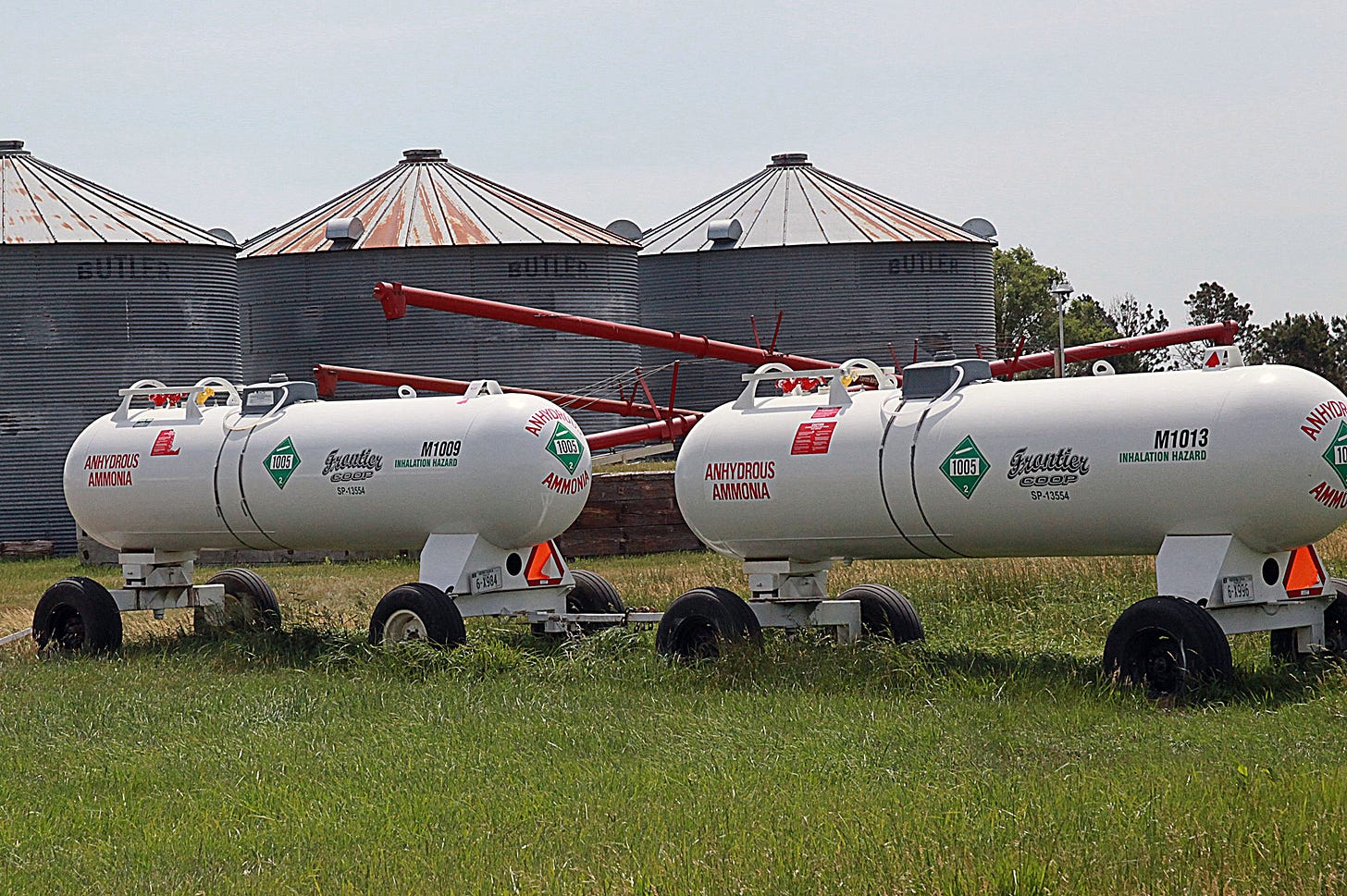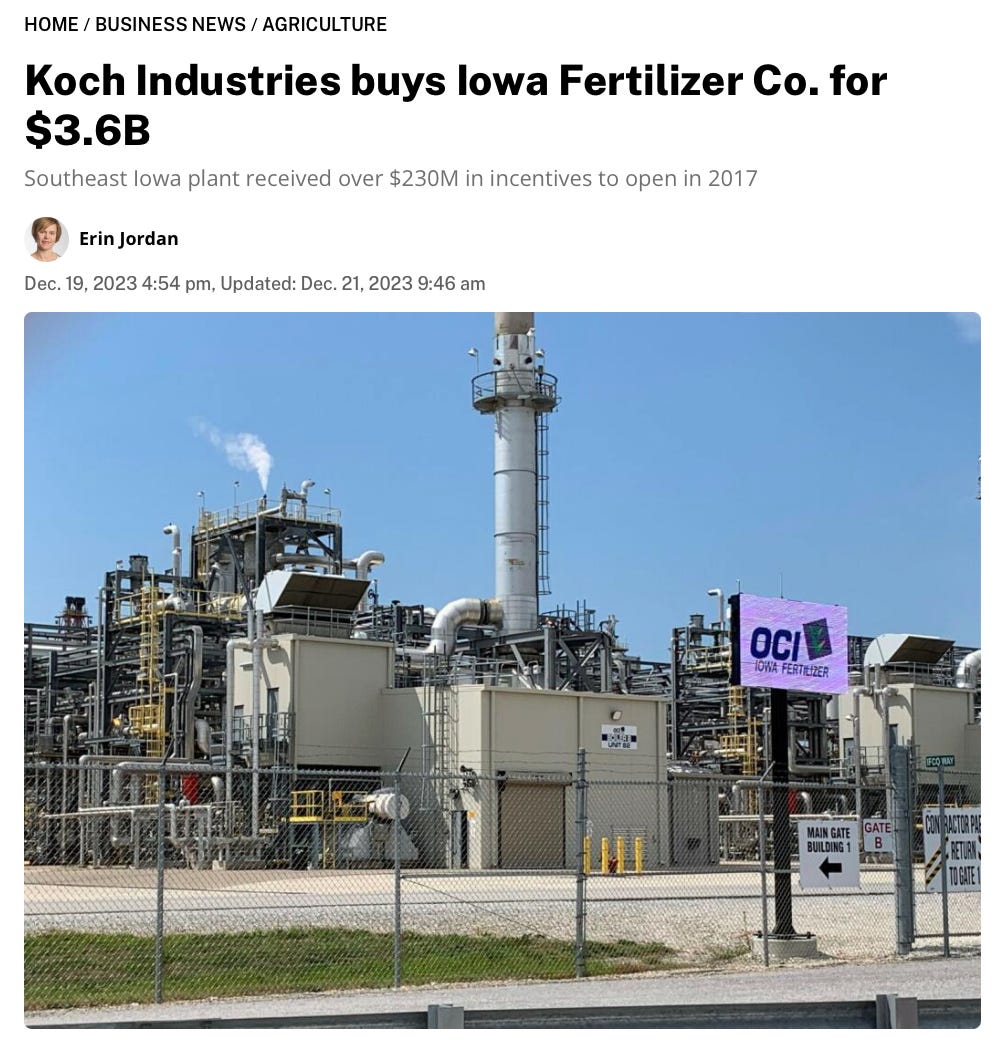Here at RiverRaccoon.substack.com, we track the price of nitrogen fertilizer, so you don’t have to. Today our top staff person noticed that the price of anhydrous ammonia (contained within those white cylindrical tanks you see parked all over rural Iowa) was $770 per ton, which is pretty darn low. That pencils out to $0.385/lb, but since ammonia is 82% nitrogen (N) by weight, the price of the nitrogen itself is $0.47/pound. This is about ½ as much as in 2022, when Vladimir Putin had everybody thinking he was about to lay claim to Europe’s best farm ground in Ukraine.
Farmers here in Iowa apply anhydrous ammonia to their fields in both fall and spring, and they also apply other formulations of nitrogen that are made from ammonia—urea, urea ammonium nitrate (UAN), monoammonium phosphate (MAP), diammonium phosphate (DAP), and a few others. Some farmers also fertilize with manure, or supplement commercial formulations with manure.
Anhydrous ammonia must, or at least should, be injected into the ground to avoid losses to the atmosphere and as such cannot be applied to a growing crop, at least not very easily. If a farmer wants to apply nitrogen to a growing crop, some other unpressurized liquid formulation of N is usually used.

MAP and DAP are solids and their use has always had a mysteriousness about it, at least for me. I don’t think many people in the industry like talking about MAP and DAP, and for good reason. Most farmers apply them in the fall or winter for the phosphorus. And while some farmers ‘count’ or ‘take credit’ for the N contained within each, it is quite vulnerable to loss. Springtime ammonia levels tend to be very high in Iowa streams following cold and snowy winters. I am convinced this is because of MAP and DAP, along with the snow capping fall-applied manure nitrogen, preventing off-gassing to the atmosphere and adding to spring runoff. When MAP and DAP are applied to snow-covered or frozen ground, the thinking is the phosphorus ‘drills down’ through the snow and attaches to soil particles, while some portion (maybe all) of the nitrogen runs off with the snow melt. This basically is why MAP exists as a product—it only has one N atom to lose instead of the two in DAP.
But back to the price--$0.47/lb. Consider this along with today’s corn price, about $4.50 for a bushel (bu), which is 56 pounds. Iowa State University has this cool website called the N Rate Calculator. Here you drop in $0.47 for the price of N and $4.50 for the price of corn, and voila, it recommends an amount of nitrogen to be applied to an acre (ac) of corn, in this case, 146 pounds if you grew soybeans on that field the previous year. If you get a corn yield of 200 bu/ac, that’s 11,200 pounds of corn grain containing 134 pounds of N that results from the 146 pounds of N you applied to the field. So if you’re following the ISU recs, you lose 12 pounds of N to the environment and/or bank some portion of that to your soil, on average.
In this scenario, 200 bu/ac brings $900 while the nitrogen cost $68.62, so your after-N revenue is $831.38 on that acre. (Bear in mind there are many other input costs, especially seeds but also machinery, pesticides, and insurance, to name a few.)
Now let’s say you are nervous that El Niño is going to bring extra rain and that you will lose some portion of your nitrogen fertilizer before your corn can assimilate it. Or let’s say salesman Troy at the Co-op has told you that the yield potential of your farm is way more than 200 bu/ac and that you’re going to leave bushels behind unless you man up on the nitrogen. Yield potential is the crop you get in a Goldilocks scenario—everything is just right—moisture, sunshine and heat are perfect, and weeds, insects, fungi and crop diseases are crushed with by your fossil-fuel derived chemical arsenal. Troy has told you that when the Goddess of Fortuna visits your farm, by god if you’re going to score, you better be ready with adequate nitrogen because she ain’t coming around but once every 10 years or so. And you don’t want to be the guy who didn’t score. And, you feel a little sorry for Troy because he’s the unlucky son-in-law that didn’t inherit any farm ground from the old man and you guys were football teammates at Alphabet Soup Consolidated High School where you would’ve been 9-man state champs had Troy not been distracted by a cute cheerleader while fielding a late 4th-quarter punt in the championship game. So you tell Troy yeah, I’ll go with 200 pounds of N instead of the 146 pounds.
But lo and behold it doesn’t end up being a Goldilocks year and you still get 200 bu/ac corn yield. Your grain is still worth $900, but you’ve spent $94.00 on N instead of $68.62. Your after-N revenue is $806, only a 3% reduction from the revenue generated by the 146 lbs/ac N rate. You lost your bet but it really wasn’t very risky: you increased your N costs 37% but it only dinged your revenue by 3%, and Troy invited you over to watch the Super Bowl on his new Sony 85” 4K Ultra HD TV that he bought with his commission from your fertilizer purchase. Ain’t nothing more American than that.
What happened to that extra 56 pounds of nitrogen that you bought? Well, some might’ve ended up sequestered in the soil but a lot of it ran off into lakes and streams or leached down into the aquifer (hmm, do you reckon that’s why the neighbor’s well is contaminated?), and some off-gassed to the atmosphere as nitrous oxide, a substance that has 300 times more warming potential than carbon dioxide. Agriculture is the source of 75% of all nitrous oxide emissions in the U.S. But hey, why worry, neither you nor Troy will suffer any penalties and the taxpayer will be asked to pay to mitigate the ecological consequences. Troy: “It’s all good, bro.”
This is the harsh math associated with nitrate pollution.
Overall nitrogen inputs in Iowa (commercial fertilizer plus applied manure N) are much more aligned with the 2nd scenario (200 lbs/ac) than the first (146 lbs/ac). Despite what you might hear about nitrogen being expensive (it’s not, really) and that farmers don’t want to lose it, many if not most corn belt farmers consciously make fertilization decisions KNOWING FULL WELL that those decisions are more likely than not to create unnecessary pollution.
The idea that this can be solved without regulating or taxing nitrogen inputs is a fantasy and always has been, and when people like Mike Naig (Iowa Ag Secretary) and Tom Vilsack (USDA secretary) tell you otherwise they are flat-out being untruthful. I suppose it is possible that they just aren’t good at math, and I must say one of the two seems thicker than Amish lumber. But with all that being said, neither one could possibly care one lick about the agronomic and bottom-line aspects of 146 pounds versus 200 pounds (of N). What do they care about? Well, they especially care about Troy’s millionaire bosses in agribusiness being able to move product. And from where I sit, neither one of them gives two shits about the hundreds if not thousands of victims of cancer and other health consequences of nitrate-laden drinking water that are a near certainty across the U.S. cornbelt (1-8).
1) Weyer, P.J., Cerhan, J.R., Kross, B.C., Hallberg, G.R., Kantamneni, J., Breuer, G., Jones, M.P., Zheng, W. and Lynch, C.F., 2001. Municipal drinking water nitrate level and cancer risk in older women: the Iowa Women's Health Study. Epidemiology, pp.327-338.
2) Jones, R.R., Weyer, P.J., DellaValle, C.T., Inoue-Choi, M., Anderson, K.E., Cantor, K.P., Krasner, S., Robien, K., Freeman, L.E.B., Silverman, D.T. and Ward, M.H., 2016. Nitrate from drinking water and diet and bladder cancer among postmenopausal women in Iowa. Environmental health perspectives, 124(11), pp.1751-1758.
3) Inoue‐Choi, M., Jones, R.R., Anderson, K.E., Cantor, K.P., Cerhan, J.R., Krasner, S., Robien, K., Weyer, P.J. and Ward, M.H., 2015. Nitrate and nitrite ingestion and risk of ovarian cancer among postmenopausal women in Iowa. International Journal of Cancer, 137(1), pp.173-182.
4) Ward MH, Kilfoy BK, Weyer P, Wang A. Cerhan JR. Nitrate intake and the risk of thyroid cancer and thyroid disease. Epidemiology 2010; 21: 389–95.
5) Brender, J.D., Weyer, P.J., Romitti, P.A., Mohanty, B.P., Shinde, M.U., Vuong, A.M., Sharkey, J.R., Dwivedi, D., Horel, S.A., Kantamneni, J. and Huber Jr, J.C., 2013. Prenatal nitrate intake from drinking water and selected birth defects in offspring of participants in the national birth defects prevention study. Environmental health perspectives, 121(9), pp.1083-1089.
6) Carrel, M., Schweizer, M.L., Sarrazin, M.V., Smith, T.C. and Perencevich, E.N., 2014. Residential proximity to large numbers of swine in feeding operations is associated with increased risk of methicillin-resistant Staphylococcus aureus colonization at time of hospital admission in rural Iowa veterans. Infection Control & Hospital Epidemiology, 35(2), pp.190-192.
7) Merchant, J.A., Naleway, A.L., Svendsen, E.R., Kelly, K.M., Burmeister, L.F., Stromquist, A.M., Taylor, C.D., Thorne, P.S., Reynolds, S.J., Sanderson, W.T. and Chrischilles, E.A., 2005. Asthma and farm exposures in a cohort of rural Iowa children. Environmental health perspectives, 113(3), pp.350-356.
8) Mathewson, P.D., Evans, S., Byrnes, T., Joos, A. and Naidenko, O.V., 2020. Health and economic impact of nitrate pollution in drinking water: a Wisconsin case study. Environmental Monitoring and Assessment, 192(11), p.724.
Below is a list of the members of the Iowa Writers’ Collaborative, of which I am a member. Please support our work by sharing and subscribing. Please consider a paid subscription. We are pleased that the Iowa Capital Dispatch republishes some of our columns. Please consider a donation to that excellent source of news and information.







Chris,
As long as we are doing sports related takes on nitrogen, it's a good time for me to roll out is my concept for nitrogen regulations based on sports salary caps. You may not like my 200 lbs/acre cap figure (I never recommend that much), but there are many farmers applying way more than that.
Premise: A farm should only be allowed to apply a finite amount of nitrogen per year, based on crop uptake and all nutrient sources. I am proposing a hard cap, not based on yield, but on a reasonable number like maybe 200 lbs/acre, maybe more stringent in areas where there are documented issues with nitrates in the groundwater.
If a farm chooses to or is forced to apply its manure or commercial fertilizer in a manner where it is more prone to being lost from volatilization, leaching, or de-nitrification from saturated soils before it is taken up by the crop being grown, it does not have the option of applying more nitrogen. The farm will have to take the yield hit from not having enough nitrogen available to grow the crop.
This will encourage farms to utilize practices to preserve/conserve nitrogen. Fall manure or anhydrous ammonia will be a lot less likely to be applied if a farm cannot add more nitrogen in the spring or in-season to make up for the amount that is lost once it has been applied. The same decisions will also have to be applied to spring liquid manure. If a farm wants to inject 12,000 gallons of liquid manure in the spring to supply 180 units of N to his corn crop, he can. However, if we have a wet spring and/or summer and Adapt N says that x amount of nitrogen was lost, the farm doesn’t get to side-dress more nitrogen, it already used its quota on that land. If volatilization of ammonia from manure into the atmosphere is a concern, the farm doesn’t get the opportunity to discount nitrogen lost in that manner, it still goes into his allocation.
A farmer can take a number of strategies with his manure or commercial fertilizer under these rules. He can reduce his manure applications per acre and plan on side-dressing, thus putting less nitrogen at risk to a loss. He can apply stabilizers on his commercial nitrogen applied pre-plant, or just plan on side-dressing the majority of it. I am not convinced that stabilizers work on manure, but maybe if there is a regulation enforced need for it, some entrepreneur will develop an effective product. There may be more cover crops to help conserve fall or winter applied manure.
A farm could always decide to keep doing what he is currently doing. He will just get less yields in years where he loses his nitrogen due to poor conservation practices because he won’t have the option of applying more. Will this increase the cost of forage and grain crops? Will some dairy farms have to have more acres to dispose of their manure? Probably, but it will likely reduce the amount of nitrogen being applied per acre in a “risky” fashion.
If you want to equate nitrogen to player salaries in sports, I picture a hard-cap like the NFL , instead of a soft cap with a luxury tax like the NBA or MLB. If you spend x amount of dollars on your Nick Foles, aka spring incorporated manure, and he/it doesn’t deliver, you don’t get to spend more on another player/N. If it was like MLB you could just keep spending on players and pay a luxury tax. I don’t think we would want that. Come to think of it, trading carbon credits is also kind of like that.
Without some cap on nitrogen applications, as long as we have “cheap” fertilizer, the only thing Adapt N does for most farms is encourage them to apply more nitrogen in a wet year.
And yes, we would have to make money available for enforcement, probably through some sort of reporting and auditing process. This really pains me to say because I hate red tape.
Thoughts are appreciated.
The criminal justice system is built around serving "justice" . 1 person, one lifer. But, if there's money to be made "justice" evaporates. Troy and Naig... can lie, the farmer can fudge and the public turns a blind eye. We vote people in that serve industry over our neighbors.
None of this would be possible if enough people stood behind you Chris and everyone else trying to speak truth to deaf ears.
What inspires people to rally around Trump. What about water quality issues, cancer rates in Iowa doesn't inspire people to run for office or vote differently.